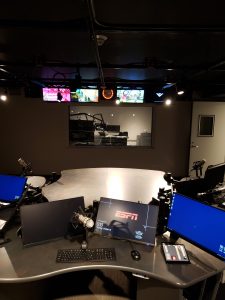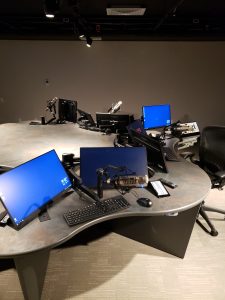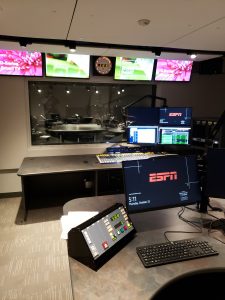Tech Focus: Sports Radio, Part 1 — ESPN Readies New Radio, Podcasting Facility
NYC studios will be an interim step to massive media complex later in the decade
Story Highlights
ESPN’s radio and podcasting will be integrated into the 19-story, 1.2 million-sq.-ft. media hub that parent company Disney will build in Manhattan’s SoHo district. That complex, scheduled to open in 2024, will be the campus for all New York City-based Disney media companies, including ESPN, Pixar, and Marvel.

ESPN Radio’s new facility is built on an AES67/AoIP core audio backbone, providing extremely low-latency streaming for both radio and podcasting.
In the meantime, Disney will open an interim radio- and podcast-production facility much sooner, at 147 Columbus Ave., in the same Lincoln Center area as its longtime home. This mezzanine facility is expected to be operational before year’s end.
After a build-out by ESPN’s technical staff led by ESPN Radio NYC Chief Engineer Rodney Belizare, the facility will house all of ESPN Radio’s New York-based work, as well as the network’s burgeoning podcast output, such as ESPN Daily, The Lowe Post, Sports With Katie Nolan, and Right Time With Bomani Jones.
ESPN and ABC, both owned by Disney, will eventually vacate the networks’ longtime Lincoln Center-area operations campuses, which have been sold to developers for a reported $1.155 billion.
Upgrade Opportunity
Though prompted by the real estate transaction, the move is viewed as an opportunity to upgrade and update the audio-centric facilities, says Kevin Plumb, VP, media engineering and operations, Direct-to-Consumer and International Technology (DCIT), Disney, whose portfolio encompasses ESPN Radio.

Disney’s Kevin Plumb says the new facility is an opportunity to improve ESPN’s audio-centric facilities.
“We’re taking it up a notch with this new complex, and we’re using it as an opportunity to make further strategic technology investments and improvements,” he says, citing what will become eight multipurpose studio/control rooms and multiple podcast-production seats, new technical core infrastructure, and related state-of-the-art audio-production technologies. “It represents the absolute latest in the state of the art for stream-first radio.”
The facilities will serve all ESPN Radio operations in New York City, such as 98.7 FM and 1050 AM, ESPN’s podcasting businesses, and some ESPN Radio Network commitments.
According to Plumb, the centerpiece technology is the facility’s AES67/AoIP core audio backbone, providing extremely low-latency streaming that will be used for both radio and podcasting. There will also be updated automation and control capability for additional audio/video functionality because, he says, “a lot of what we do is radio on TV,” a reference to shows like Yankees announcer Michael Kay’s Centerstage show, which are shown as video feeds on some of ESPN’s television channels and are simulcast on ESPN Xtra.
Radio Remains a Focus

One of eight multipurpose studios and multiple podcast-production rooms in ESPN Radio’s new interim facility
Although podcasting is getting a lot of attention at the moment, radio will remain a focus for ESPN, says Plumb: “We know that fans are driving cars, consuming a great deal of audio in their cars on their way to work. We’re there, whether AM/FM radio, Sirius XM, podcasts.
“We look at it as we’re focusing first on content,” he continues. “That’s one of the reasons we go to great lengths to make sure that our production and distribution systems are efficient and the most state-of-the-art possible.”
The interim facility will address recent changes in remote production brought on by the pandemic most recently and by the longer-term economics of broadcast sports. It will feature a heavier reliance on IP-based connectivity, with more remote workers sharing centrally located key technology platforms, such as cloud-based audio services.
“Before COVID-19, many of our talent were already working remotely in this mode,” he points out. “The big change has been [to remotely integrate] our production staff and our producers so that they can contribute from their home location. And we’re also adding functionality so that we can provide video on some of these remote packages: for example, games could be called off of a personal computer, and we can time-align that video so that, for an MLB event, the announcers could be in Colorado and Idaho calling the same game, with a producer operating out of Florida. We can time-align them all with custom video views so that they can [produce] a game together from wherever they are.”
ESPN’s vast content archives will also be made more available to radio and podcast producers, part of what Plumb says will be an even greater emphasis on storytelling and narrative in those productions.
“Our ESPN TV and related production units are driving a great deal of this new effort into podcasting and storytelling,” he explains, adding that the new facilities are designed so that producers and podcasters can more easily access that content reservoir. “Radio facilities traditionally weren’t designed for that kind of approach. Now we see all of the audio media as a narrative media, with the same assets accessible to both radio and podcasting over IP. We’re creating a hub for all of that.”
Click here for Tech Focus: Sports Radio, Part 2 — The Future Is Streaming, Multichannel
Click here for Tech Focus: Sports Radio, Part 3 — Audio Consoles Keep Pace With Tech Advances

